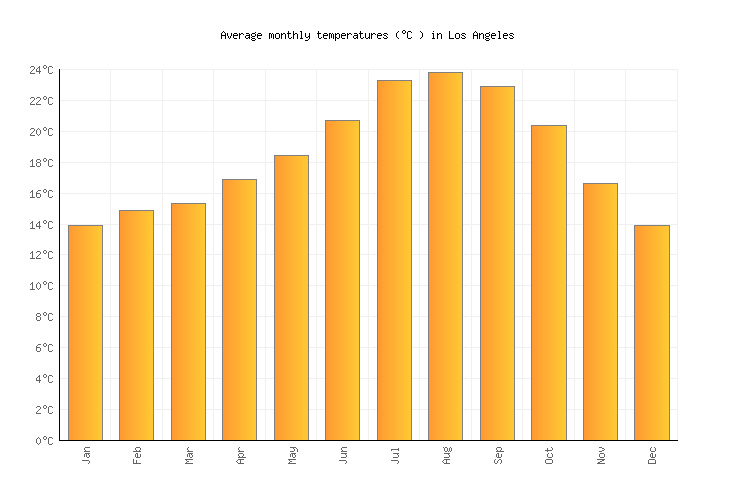

However, after the rare cold air outbreaks, the night temperature can approach freezing (0 ☌ or 32 ☏). There are many pleasant and sunny days, with daytime temperatures around 20 ☌ (68 ☏). Winter, from December to March, is a very mild and spring-like season. Sometimes, the Santa Ana winds can spread fires. San Fernando Valley (see San Fernando, Van Nuys, Burbank, Glendale), north-west of the city, being closed between the hills, is even hotter, so much so that the highest records are about 46/47 ☌ (115/117 ☏). The highest recorded temperature was measured on September 27, 2010, with 44.5 ☌ (112 ☏) in the city center and 40.5 ☌ (104.5 ☏) at the airport, which is located on the coast.

Heat waves due to this wind occur more often in September, followed by August, July and October.

When it blows, the temperature can go above 25 ☌ (77 ☏), and sometimes up to 30 ☌ (86 ☏), in the middle of winter, while it can go above 35 ☌ (95 ☏), and sometimes up to 40 ☌ (104 ☏), from from April to October. This wind is more likely to occur in autumn and winter, but it can blow all year round. In addition to the possible waves of bad weather, which occur mainly from December to March, a nuisance in the climate of Los Angeles is represented by the Santa Ana, a hot, dry wind from the northeast, which blows for a few days from the deserts of California and Arizona, after passing over the mountains, from which it descends. The city is quite polluted, and pollutants can accumulate in the air especially in the dry season, from May to October. There are, however, different microclimates depending on area, since the city covers a wide surface, it is situated on the coast, but it's also surrounded by hills and mountains. The city has therefore a really pleasant climate, also because it is kissed by the sun most of the year. In fact, the city is located at a lower latitude than the Mediterranean coasts, so it has milder winters on the other hand, it is located on the Pacific coast, along which a cool current flows (ie the California Current) therefore, summer is a bit cooler than in the Mediterranean Sea. It is similar to the Mediterranean climate but it's even milder.
#Los angeles weather june full#
Please review our full terms contained on our Terms of Service page.The climate of Los Angeles is subtropical, characterized by very mild, relatively rainy winters and hot, sunny summers. We further caution that our travel scores are only as good as the data that underpin them, that weather conditions at any given location and time are unpredictable and variable, and that the definition of the scores reflects a particular set of preferences that may not agree with those of any particular reader. While having the tremendous advantages of temporal and spatial completeness, these reconstructions: (1) are based on computer models that may have model-based errors, (2) are coarsely sampled on a 50 km grid and are therefore unable to reconstruct the local variations of many microclimates, and (3) have particular difficulty with the weather in some coastal areas, especially small islands. We draw particular cautious attention to our reliance on the MERRA-2 model-based reconstructions for a number of important data series. We assume no responsibility for any decisions made on the basis of the content presented on this site. Weather data is prone to errors, outages, and other defects. The information on this site is provided as is, without any assurances as to its accuracy or suitability for any purpose. See all nearby weather stations Disclaimer The details of the data sources used for this report can be found on the Los Angeles International Airport page.


 0 kommentar(er)
0 kommentar(er)
